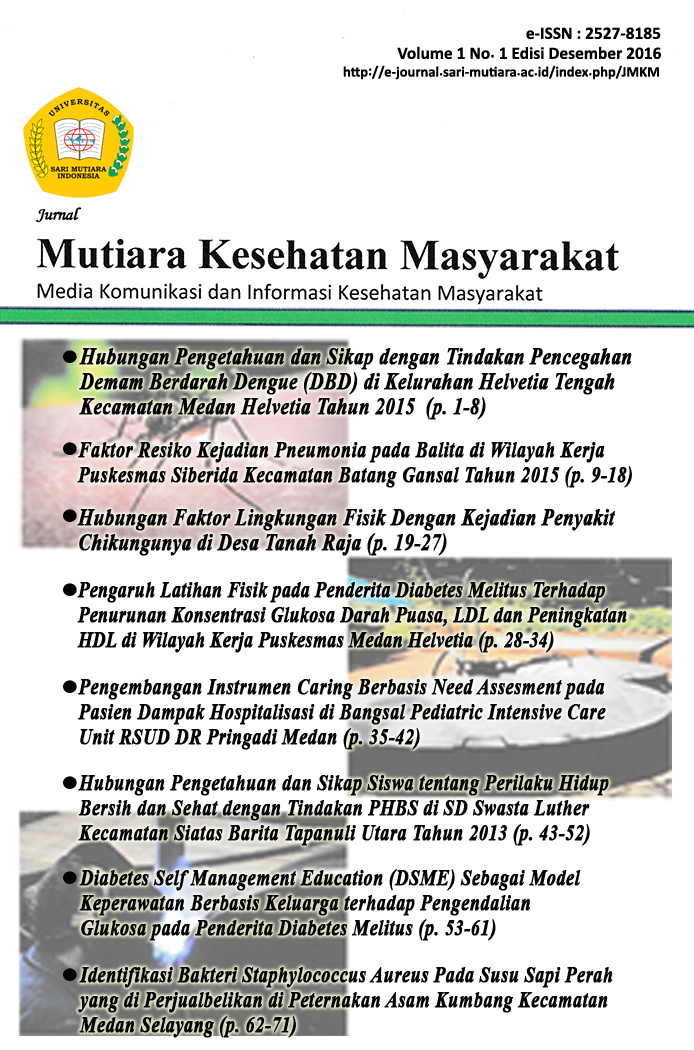FAKTOR- RISIKO KEJADIAN PNEUMONIA PADA BALITA DI WILAYAH KERJA PUSKESMAS SIBERIDA KECAMATAN BATANG GANSAL TAHUN 2015
Abstract
Good housing is composed of a collection of houses that are equipped with numerous amenities such as a means of supporting roads, channels dirty water, trash, clean source of water, and close to the Centre of public health. Residential location should be free of flooding according to the standard public housing architecture. Essentially intended to provide a reasonably good home living in the form of design, layout and spacious room and other facilities in order to meet the needs of a family or can meet the requirements of home living a healthy and fun. Home or a bad place to live (slums) can support the occurrence of transmission of diseases and health problems, including pneumonia, Acute Respiratory tract infections (RESPIRATORY) remains an important health issue, because they caused the deaths of babies and toddlers. In case of discovery of Indragiri Hulu Regency of RESPIRATORY 2013 is the first rank of the 10 biggest disease, as many as 35.339 cases (34,09%), followed by as many as 10.981 gastritis disease cases (10,59%). This disease from year to year is always the first, caused by environmental conditions, where almost every year of Indragiri Hulu Regency got a flood and smoke that affect the respiratory tract and other causes. Pneumonia in Indragiri Hulu Regency in 2015 found as many as 220 cases amounted to 6.1%, we can see in the table below with a case of pneumonia in the Indragiri Hulu Regency:for that researchers want to find out to find out the risk factor for the occurrence of Pneumonia on Toddlers in the working area Clinics Batang Gansal Siberida 2015. With regard to this type of research is observational studies are retrospective (observations) with the design of the case case control. The overall population is a subject or object that will be examined, in this research is children aged under 59 months (toddler) 119 people. After analyzed results obtained the value of the P value of ventilation and OR 0.9, P value = 0.000 P humidity value = 0.000 fuel and OR 15,867, P value insect repellent and OR 0.667 valu memerokok, P = 0.000 and OR 2,240, P value behavior and OR 277,5, meaning that all the variables influencing the incidence of pneumonia.
Downloads
References
Achmadi, U F, 2012. Manajemen Penyakit Berbasis Wilayah Edisi Revisi, Penerbit Raja Grafindo Persada,Jakarta.
Depkes RI, 1999. Keputusan Menteri Kesehatan RI No 829, Menkes/SK/VII/1999 tentang Persyaratan Kesehatan Perumahan , Depkes RI, Jakarta.
Depkes RI, 1999. Keputusan Menteri Kesehatan RI No 829, Menkes/SK/VII/1999 tentang Persyaratan Kesehatan Perumahan , Depkes RI, Jakarta.
Aditama, C. Y, 1996. Perkembangan di Bidang Penangulangan Tuberkulosis paru, Majalah Kesehatan Masyarakat edisi XXIV Nomor 6, Jakarta
Aditama , Tjandra Yuga, 1997. Tuberculosis Paru, Masalah dan Penaggulangannya, Penerbit Universitas Indonesia (UI-Press) Jakarta
Chandra, B., 2007. Pengantar Kesehatan Lingkungan. Buku Kedokteran EGC, Jakarta
Badan Litbangkes Depkes RI, 2010. Riset Kesehatan Dasar 2010, Jakarta
Candra Budiman, 2007. Pengantar Kesehatan Lingkungan, IGC Jakarta.
Departemen Pendidikan Nasional, 2002. Kamus Besar Bahasa Indonesia. Edisi kedua, Balai Pustaka. Jakarta.
Depkes R.I., 2006. Rencana Strategis Departemen Kesehatan Tahun 2005-2009. Depkes RI, Jakarta
Depkes RI, 1999. Keputusan Menteri Kesehatan RI No 829, Menkes/SK/VII/1999 tentang Persyaratan Kesehatan Perumahan , Depkes RI, Jakarta.
Kristina, R.H., 2000. Analisis Faktor Risiko Terjadinya Pneumonia pada Anak Balita di Kabupaten Dati II Boyolali. Tesis-S2, UGM, Yogyakarta.
Kunopruntanto, Haryoto, Dewi, 2000. Kesehatan Lingkungan Pemukiman Penduduk. Bulletin Penelitian Kesehatan, Jakarta.
Mukono, H.J., 2006. Prinsip Dasar-Dasar Kesehatan Lingkungan, Airlangga University Press, Surabaya
Murti, B., 2006. Desain dan Ukuran Sampel Untuk Penelitian Kuantitatif dan Kualitatif di Bidang Kesehatan. Gadjah Mada University Press, Yogyakarta
Notoatmodjo, S., 2006. Pendidikan dan Perilaku Kesehatan. Rineka Cipta, Jakarta
Pradono, J., Kristianti, Ch.M., Supraptini, 2005. Gambaran Rumah Tangga dan Faktor yang Berperan, Surkesnas 2001. Majalah Kesehatan Perkotaan Vol. 12 No.1, 2005. Yogyakarta
Rifai, Wulandari R.A., Purwana R., 2004. Hubungan Faktor Lingkungan Rumah dan Karakteristik Individu dengan Gangguan Saluran Pernafasan Anak Balita di Wilayah
Puskesmas Pekik Nyaring Kabupaten Bengkulu Utara Provinsi Bengkulu Tahun 2004. Jurnal Kedokteran dan Farmasi Medika, Jakarta
Situmorang, B., Parulian, 2002. Debu Particulate Matter (PM10) Udara Rumah Tinggal dan Kejadian Penyakit Infeksi Saluran Pernafasan Akut (ISPA) pada Balita di Kelurahan Cakung Timur, Kodya Jakarta Timur Tahun 2002. Jurnal Kedokteran dan Farmasi Medika, Jakarta
Soemirat, J., 2005. Epidemiologi Lingkungan. Gadjah Mada University Press, Yogyakarta
Supardi, S., Pramono, D., Nawi, 2000. Statistik Kesehatan. Bagian Ilmu Kesehatan Masyarakat, Fakultas Kedokteran UGM, Yogyakarta.
Sutrisna, Bambang, 1993. Faktor Risiko Pneumonia pada Balita dan Model Penanggulangannya. Majalah Kesehatan Masyarakat Indonesia, Jakarta
Victoria, C.G., Kirkwood, B.R., N., Fuchs, S.R., Flores, J.B., Misago, C., 1994. Risk Factor For Pneumonia Among Children In a Brazillian Metropolitan Area, Pediatrics








 This work is licensed under a
This work is licensed under a 



.png)



